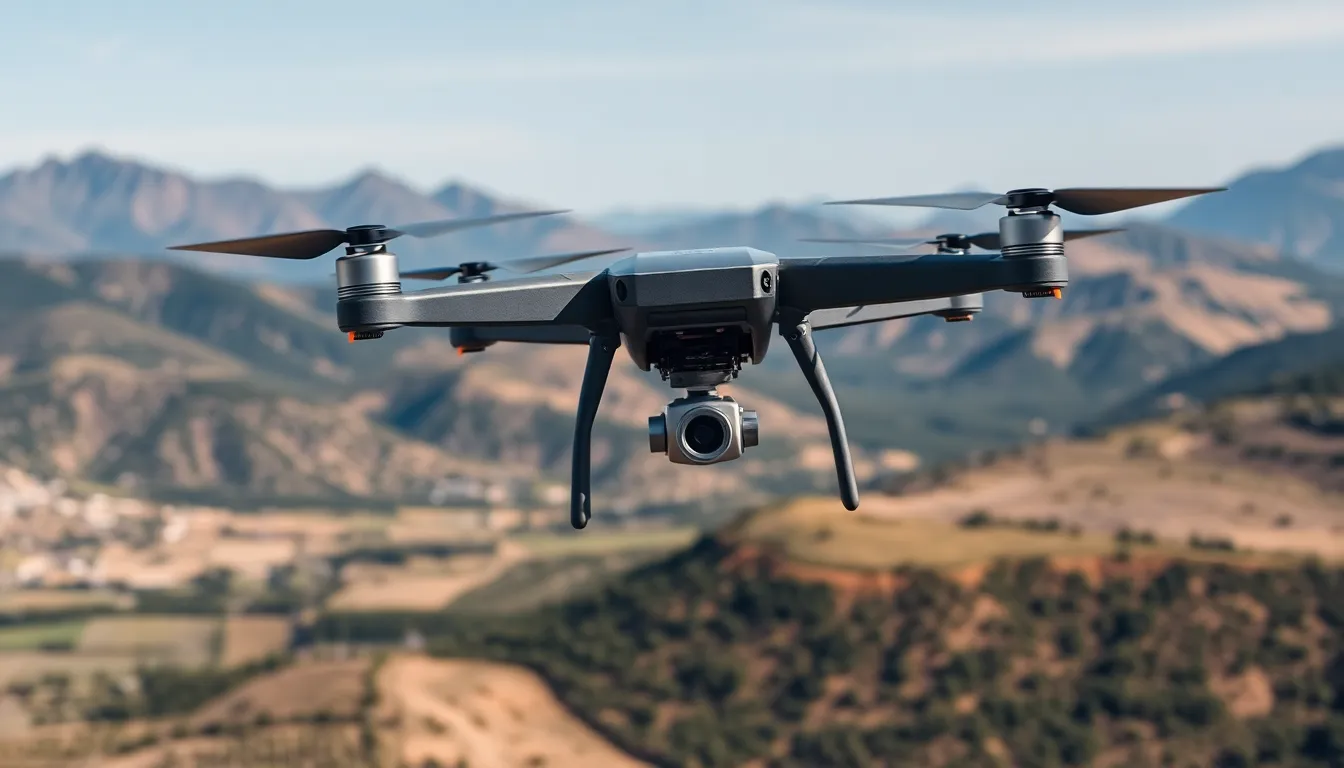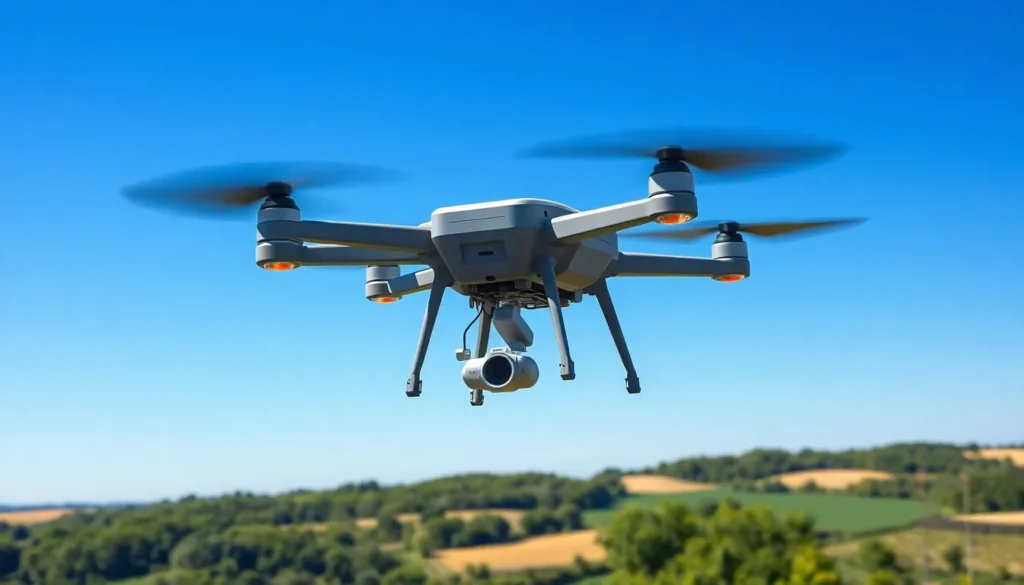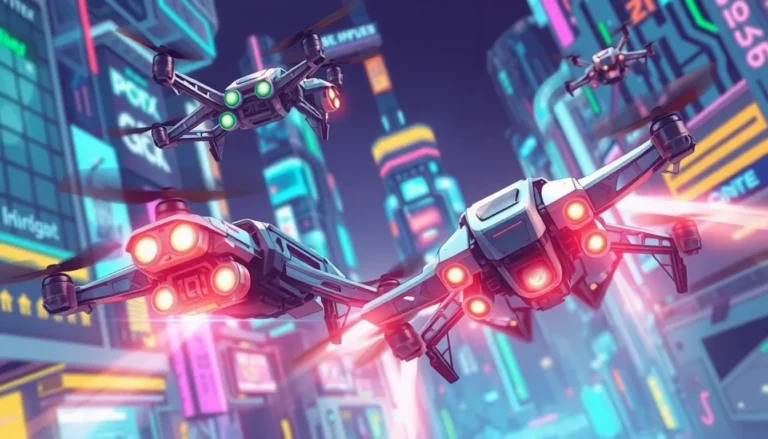Table of Contents
ToggleIn a world where drones are the new superheroes of technology, understanding their telemetry systems is like unlocking the secret to their superpowers. Imagine a bird that not only flies but also talks back, sharing its every move, altitude, and even battery life. That’s telemetry for you—turning these flying gadgets into data-driven dynamos.
Overview of Drone Telemetry Systems
Drone telemetry systems serve as crucial components in modern unmanned aerial vehicles. These systems facilitate real-time data transmission between the drone and the ground station. Telemetry includes various metrics, such as GPS location, altitude, speed, and battery status. Accurate monitoring of this information enhances the safety and efficiency of drone operations.
A specific example of telemetry application involves using GPS signals for precise location tracking. This allows operators to navigate drones effectively, enabling automated flight paths and mission planning. Data logging features also contribute valuable insights post-flight, helping with further analysis and performance optimization.
Telemetry systems function through multiple communication methods. Common techniques include radio frequency signals, cellular networks, and satellite communication. Each method offers distinct advantages, such as extended range or increased reliability.
Different telemetry systems cater to various types of drones. Consumer drones often utilize simpler systems with limited range and data types. Conversely, commercial and military drones may incorporate advanced telemetry systems capable of handling complex data streams. These advanced systems aid in mission-critical tasks, from surveillance to environmental monitoring.
Robust telemetry systems not only improve operational efficiency but also enhance safety protocols. Continuous monitoring allows operators to detect potential issues, such as low battery levels or loss of signal. Immediate corrective actions can significantly reduce the risk of malfunctions or accidents.
The effectiveness of drone telemetry systems lies in their ability to provide essential data for both navigation and safety. Their integration into drone technology represents a key advancement, enabling a wide array of applications across different industries.
Key Components of Drone Telemetry Systems

Drone telemetry systems comprise essential elements that facilitate real-time data flow. These components enable drones to operate efficiently and safely.
Sensors and Data Acquisition
Sensors capture critical information regarding the drone’s environment and performance. Common sensor types include GPS, accelerometers, gyroscopes, and altimeters. GPS sensors provide precise location data, while accelerometers measure acceleration rates. Gyroscopes maintain orientation stability, and altimeters gauge altitude. Data acquisition systems consolidate this information, ensuring accurate data transmission to ground stations. These sensors work collaboratively, enhancing situational awareness and enabling drones to adapt to changing flight conditions.
Communication Protocols
Communication protocols define the methods used for transmitting data between drones and ground control. Popular protocols include MAVLink, FrSky, and DJI’s OSDK. Each protocol operates on distinct frequencies, optimizing range and reliability. For example, MAVLink allows for efficient communication in various applications, like agriculture and surveying. It enhances data-sharing capabilities, ensuring seamless integration with different ground systems. Reliable communication minimizes latency and enhances operational safety during missions. Drones equipped with robust protocols can transmit data even in challenging environments, making them essential for modern aerial operations.
Benefits of Using Drone Telemetry Systems
Drone telemetry systems offer significant advantages for various applications. They facilitate efficient operation while significantly improving the safety and effectiveness of drone flights.
Enhanced Data Collection
Enhanced data collection is one of the primary benefits of drone telemetry systems. Sensors gather critical information such as temperature, humidity, and environmental conditions during flight. This data provides valuable insights for industries like agriculture and construction. Utilizing GPS data helps in mapping out precise locations for further analysis. Continuous data flow contributes to better decision-making and strategic planning.
Real-Time Monitoring
Real-time monitoring plays a crucial role in drone operations. Operators receive immediate updates about drone status, including battery life and system health. Such timely information allows for quick responses to potential issues, reducing risks during missions. Monitoring is essential for compliance in commercial and industrial sectors, where regulations dictate safety measures. Having access to real-time data ensures that drones operate within defined parameters, enhancing overall mission success.
Challenges in Drone Telemetry Systems
Telemetry systems in drones face several significant challenges, impacting their efficiency and reliability. Addressing these challenges is vital for optimizing drone operations.
Signal Interference
Signal interference poses a major issue in drone telemetry systems. Obstacles like buildings, trees, and other environmental factors disrupt radio frequency signals. These disruptions can lead to lost data and decreased control over the drone. For consumer drones, which typically operate within limited ranges, interference can severely hinder performance. Commercial drones often use advanced frequency-hopping spread spectrum techniques to mitigate this problem. Employing different communication frequencies enhances reliability, ensuring clearer data transmission. Maintaining strong signal integrity is crucial for real-time operations, especially in urban settings where interference rates tend to be high.
Data Security Concerns
Data security remains a pressing concern for drone telemetry systems. Unauthorized access to sensitive data can lead to potential misuse or privacy violations. Encryption methods serve as essential safeguards, protecting the information transmitted between drones and ground control. Drones often transmit critical data, including flight paths and sensor measurements, which are prime targets for cyber threats. Implementing robust cybersecurity protocols, such as multi-factor authentication, enhances system security. Additionally, compliance with regulations, like GDPR and FAA guidelines, ensures data protection and fosters trust among users. Addressing these data security concerns is essential for the safe deployment of drone technologies.
Future Trends in Drone Telemetry Systems
Emerging technologies are shaping the future of drone telemetry systems. Artificial intelligence integration enhances data analysis capabilities, allowing drones to make real-time decisions based on telemetry data. Increased reliance on AI will improve flight autonomy and operational efficiency across various industries.
5G technology’s rollout significantly affects telemetry systems. Faster data transmission rates enable drones to send and receive larger volumes of information quickly. This advancement supports high-definition video streaming, crucial for applications in surveillance and real-time monitoring.
Miniaturization of components is another notable trend. Advancements in sensor technology result in smaller, lighter devices that fit seamlessly into drone designs. Compact sensors enhance overall drone performance while maintaining reliability in data collection.
Cloud computing plays an essential role in the evolution of telemetry systems. Utilizing cloud platforms for data storage and processing ensures easy access to data analytics and historical flight records. This trend simplifies collaboration among multiple users while ensuring data integrity and security.
Furthermore, increased focus on regulatory compliance drives innovations in telemetry systems. Adapting to evolving regulations enhances air traffic management and drone coordination. Improved telemetry systems will support safety protocols, ensuring that drones operate efficiently within crowded airspaces.
Lastly, augmented reality integration transforms how operators interact with drones. AR applications provide real-time visual data overlays, enhancing situational awareness. As drone operators receive critical information through AR, decision-making becomes more informed and timely.
Drone telemetry systems are reshaping the landscape of aerial technology. By enabling real-time data transmission and enhancing situational awareness, these systems play a vital role in ensuring safe and efficient drone operations. As industries continue to adopt drone technology, the integration of advanced telemetry solutions will drive innovation and improve operational effectiveness.
With the rise of artificial intelligence and 5G technology, the future of drone telemetry looks promising. Enhanced data analysis and faster communication will empower operators to make informed decisions quickly. As challenges such as signal interference and data security are addressed, the reliability of these systems will only improve, paving the way for broader applications and increased trust in drone technology.







